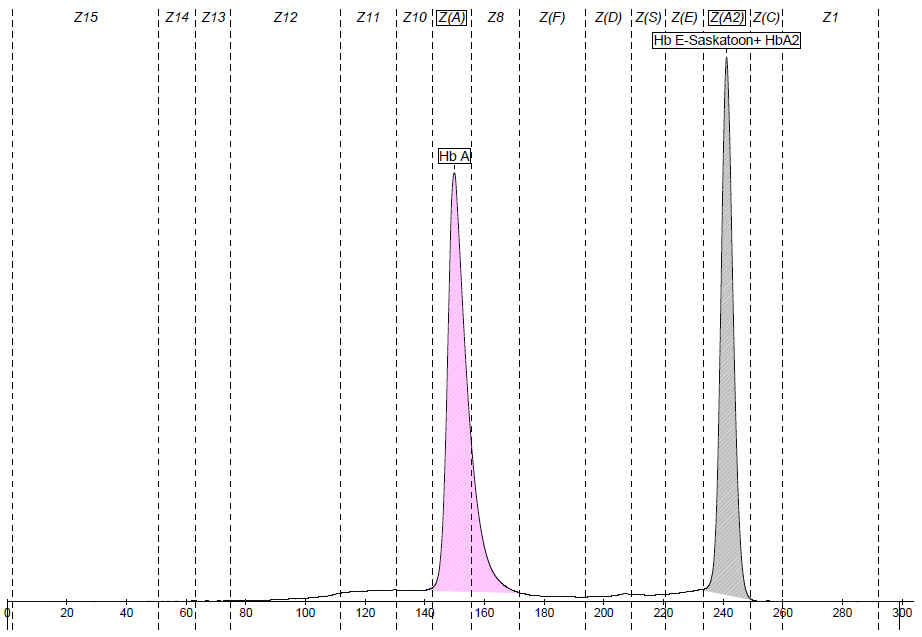General information
Globin chain involved
Status
Heterozygous
Migration zones
Migration positions
241
Sickle Cell Disease: No
Thalassemic variant: No
Capillary Electrophoresis
Fractions
Value %
Hb A
55.7
Hb E-Saskatoon + Hb A2
44.3
Comments
Mutation data
Heterozygous Hb E-Saskatoon
Mutation
HGVS Nomenclature
Beta 22(B4) Glu>Lys
HBB:c.67G>A
Hematological parameters
Name
Result
RBC Count
Normal
Total Hemoglobin
Normal
MCV
Normal to low
MCH
Normal to low
Blood smear
No information
Other analysis
Normal hematocrit
Comments on hematology
Normal
Clinical context
Clinical presentation
Normal
Clinical risk
No data
Variant information
Stability
Normal
Oxygen affinity
No data
Ethnicities in literature
Found in Caucasian, Mediterranean & Asian populations: met in several families of Scottish descent (possible origin from the Orkney Islands) in Scotland & Canada, in a 14-month-old Turkish female and her family and other Turkish families, in a 57-year-old Japanese male, in some Greek, Spanish and Brazilian families
Comments on variant information
The rare variant Hb E-Saskatoon has been found in combination with beta-thalassemia type IVS-I-6 (T-->C) in a Turkish infant and in homozygous status in a Turkish female, with normal clinical presentation for both of them. Hb E-Saskatoon has also been observed in combination with Hb S and with Hb Lepore-Baltimore.
Scientific Literature
Scientific references
- https://pubmed.ncbi.nlm.nih.gov/939569/ Tills D. et al., Hum Genet. 1976 Jul 27;33(2):179-80.
- https://pubmed.ncbi.nlm.nih.gov/2283299/ Gurgey A. et al., Hemoglobin. 1990;14(4):449-51.
- https://pubmed.ncbi.nlm.nih.gov/8718699/ Igarashi Y. et al., Hemoglobin. 1995;19(6):403-6.
- https://pubmed.ncbi.nlm.nih.gov/11791874/ Birben E. et al., Hemoglobin. 2001 Nov;25(4):409-15.
- https://pmc.ncbi.nlm.nih.gov/articles/PMC4171515/ Srivorakun H. et al., PLoS One. 2014 Sep 22;9(9):e108365.
- https://pubmed.ncbi.nlm.nih.gov/24081202/ Couto GK. et al., Acta Haematol. 2014;131(2):84-7.
- https://pubmed.ncbi.nlm.nih.gov/29365076/ Riou J. et al., Am J Clin Pathol. 2018 Jan 29;149(2):172-180.
Globin Chain involved
Status
The term "Double Heterozygous" refers to cases of heterozygosity on different globin chain types, while the term "Compound Heterozygous" refers to cases of heterozygosity on the same globin chain type.
For example, S/G-Pest is a Double Heterozygous case (beta and alpha-globin chains are mutated) and S/C is a Compound Heterozygous case (only beta-globin chains are mutated).
Migration zones
Migration positions
Sickle Cell Disease
Thalassemic variant
Capillary Electrophoresis
Variant information
Ethnicities are provided for informational purposes only and are based on scientific literature and conference posters.
A hemoglobin variant may therefore be present in populations of ethnic origins or countries not listed here.

